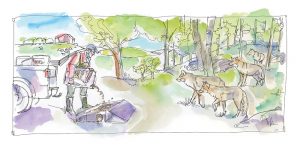True confessions from the 9th Concession
by Dan Needles ❧ illustration by Shelagh Armstrong-Hodgson

When the snow finally retreated this past spring, someone made a grisly discovery on a secluded lot at the edge of town. Scattered within a few yards were a dozen pet collars lying in the grass, all that was left of various cats and dogs nabbed and carried there by coyotes over the winter.
Biologists tell us that edge communities produce the greatest diversity of species. In the band where the savannah meets the rainforest or the city meets the country, you will find creatures who have figured out how to adapt to both environments. Coyotes, squirrels, skunks, raccoons, rabbits, rats and mice all push their way into our lives as they try to make a living. It’s a natural instinct for us to push back.
We have kept sheep for 30 years on this little farm and we take the usual precautions. They pasture next to the house during the day and we lock them into a barn at dark. We’ve lost only one lamb over that time and that was from a daylight raid by a big mongrel animal who disrupted the sideroad for several weeks until a farmer finally shot him.
Coyotes are like hotel burglars. They won’t force a lock, but if a door is left open, they will slip in and strip the place to the walls. They are extremely cautious and can live on next to nothing. They are also opportunists. I know one sheep farmer who has been pasturing his flock on a large field for 25 years without losing a single one to a coyote. His secret? He feeds the coyotes dog kibble out of covered bait stations located at each corner of the pasture.
His theory is that the most vigilant and effective control for coyotes is another coyote. They know a good deal when they see one and will fiercely defend territory that offers a steady supply of food and no harassment. His efforts have produced a group of “settler” coyotes who drive off any of their itinerant cousins who try to muscle in and upset the balance.
This is probably the same process that led to the domestication of the dog somewhere between 20,000 to 40,000 years ago. My friend believes that if his children and grandchildren continue feeding these coyotes long enough, they will eventually have one living under the veranda and barking at incoming cars.
Another old sheep farmer told me years ago that if your coyotes aren’t causing a problem, “Don’t start anything.”
But if you have lost a loved pet to a coyote, you are entitled to the feeling something should be done. I picked up a gun myself and joined the torchlight posse that went after the marauder who killed my lamb. Biologists will tell you that any attempt to cull predators always produces the same result: litter sizes jump from two to nine and the population recovers within the year. An ounce of prevention is always worth a pound of retaliation.
We have an Akbash livestock protection dog who very much looks the part but hasn’t done any of the reading. He hails from a long line of herd dogs that stretches back to the rugged foothills of Anatolia in Turkey. The book says the breed is reserved, wary, constantly on guard and fiercely loyal. My Dexter is genial, delighted you dropped in and usually asleep on my pillow in the master bedroom. He’s not that interested in sheep. He does make his rounds every morning, peeing on fence posts and woofing impressively at the forest. But he’s like a Walmart greeter for the rest of the day. This, too, is a principle of evolution. Any species that hangs around humans for long enough inevitably learns co-operation, tolerance and gentleness. The trick with the Akbash is to keep him out in the fields with the flock and never introduce him to central air.
The arc of the universe bends a different way for us than it does for a coyote. Scientists say we got friendly long before we got smart. The biggest and oldest part of the human brain is a sophisticated emotion detector that figures out how other people feel about us and whether it is safe to approach them. The frontal cortex, the part of the brain that designs weapons and organizes a posse, is a very recent after-market adaptation, like a sunroof, and we’re still learning how to use it. ❧
Author and playwright Dan Needles is the recipient of the Stephen Leacock Medal for Humour. His latest book, True Confessions from the Ninth Concession (Douglas & McIntyre), is a collection from 20 years of his columns for On The Bay and other publications.













